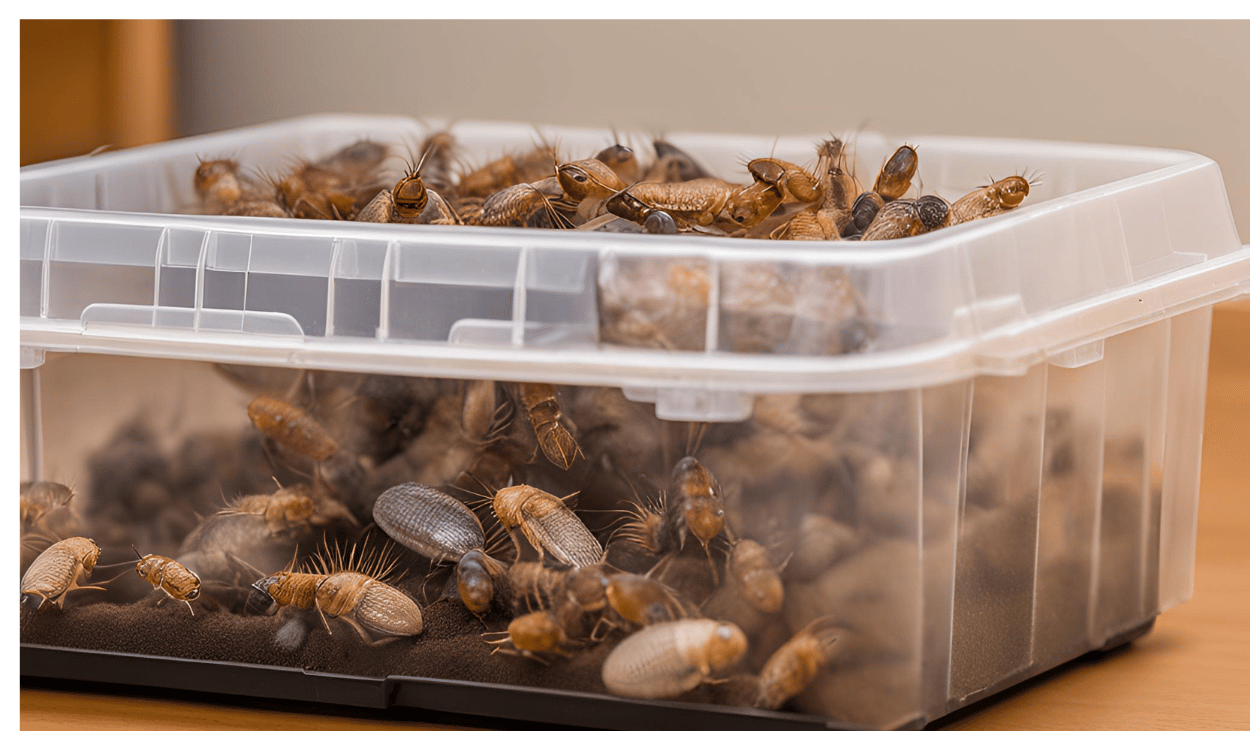Are you tired of constantly buying feeder insects for your bearded dragon? I get it!
Breeding Dubia roaches for your bearded dragon is easier than you think!
So, how to breed dubia roaches for bearded dragons? First, you’ll need a plastic bin with air holes, egg cartons for hiding spots, and a heat source to keep the temperature around 90°F.
Feed them fresh fruits, veggies, and a high-protein roach chow. Make sure to keep the humidity moderate and provide water crystals to prevent drowning.
Soon, you’ll see baby roaches—don’t worry, it takes a few weeks! It’s exciting to watch your colony grow and know you’re giving your bearded dragon the healthiest, home-bred food.
Trust me, once you start, you’ll never go back to buying roaches!
Ideal Conditions for Breeding Dubia Roaches
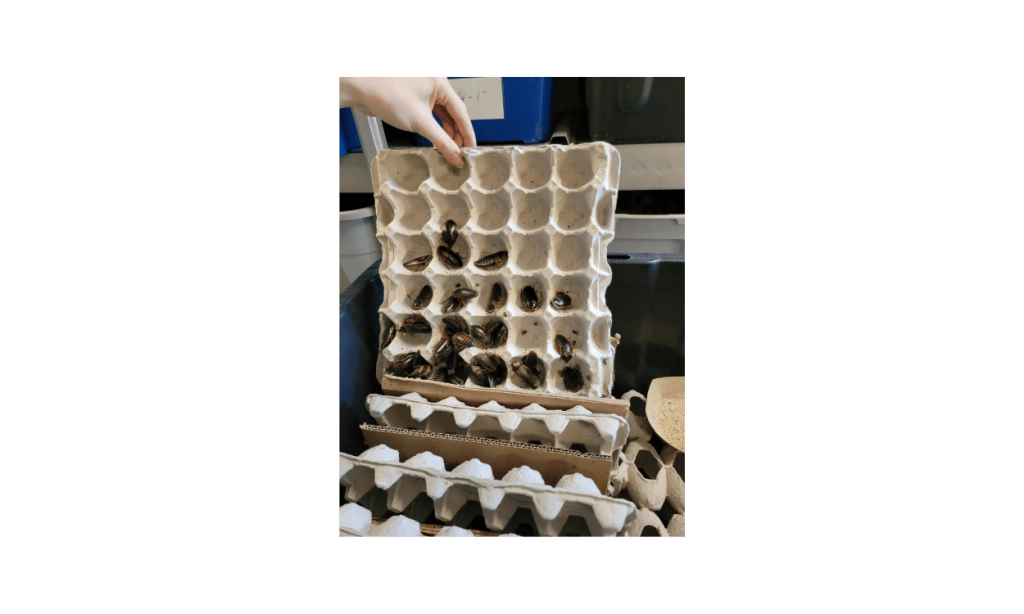
To make sure your Dubia roaches are breeding happily, you’ll need to create just the right environment. Here’s what your roaches need to thrive
Temperature
Dubia roaches are like us—they love warmth! To get them in the mood for breeding, keep the temperature between 85-90°F (29-32°C). This cozy warmth helps them grow faster and encourages them to mate.
You can use a heat mat or lamp under one side of the container to create a warm spot, and a thermostat can help keep everything steady.
Humidity
Roaches don’t need a much humid environment, but a bit of moisture helps them stay healthy. Aim for 40-60% humidity in their home.
This level keeps them from drying out without making things too damp. You can check the humidity with a hygrometer and adjust it by adding a small amount of water crystals or a damp sponge.
Lighting
While Dubia roaches don’t rely on lighting for breeding, having a regular light cycle helps them stay active. A simple 12-hour light and 12-hour dark cycle is perfect.
This mimics their natural day and night pattern and keeps your roaches happy and healthy. You don’t need fancy lighting—just a regular light source will do!
Life Cycle of Dubia Roaches
You want to know how to breed dubia roaches for bearded dragon. Right? The idea of their life cycle will greatly help you through the breeding process. Also, it helps you manage your colony better. Here’s a quick rundown of their life stages
| Stage | Description | Duration |
| Egg Stage | Female produces oothecae (egg cases) containing 30-40 eggs. Oothecae are carried for 30 days. | About 30 days |
| Nymph Stage | Eggs hatch into small, wingless nymphs that molt several times. Needs plenty of food and water. | 2-3 months |
| Adulthood | Nymphs become adults. Males are smaller with longer wings; females are larger. | 6-12 months |
| Breeding Timeline | 1-2 months from introducing a breeding pair to the first batch of nymphs appearing. | 1-2 months |
How to Care for Dubia Roaches
Caring for Dubia roaches is essential if you want them to thrive and breed efficiently. Let’s break it down into the key aspects of care: feeding, watering, and cleaning.
Each plays a vital role in keeping your roach colony healthy and productive.
Feeding the Roaches
Dubia roaches are easy to feed, but providing them with the right nutrition is key to keeping your colony healthy and your bearded dragon well-fed.
These roaches thrive on a diet rich in protein and vegetables. A balanced diet makes them more nutritious for your bearded dragon. You can feed them a variety of foods such as
- Commercial Roach Chow: This is a balanced, nutritious food designed specifically for roaches. It typically contains a mix of grains, proteins, and vitamins.
- Ground Dog or Cat Food: These provide high protein, but make sure they’re not too greasy or filled with artificial ingredients.
- Fruits and Vegetables: Fresh options like carrots, apples, sweet potatoes, oranges, and bananas provide moisture and essential vitamins. Carrots are especially good since they stay fresh for longer.
However, avoid foods that spoil quickly, like cucumbers or leafy greens, as they can lead to mold or attract unwanted pests.
How Often Should You Feed Them?
Feed your colony every 1-2 days. Make sure they always have access to dry food, as well as some fresh fruits or veggies.
A hungry roach won’t grow or breed well, so consistent feeding is important. Just be mindful of how much fresh food you offer to prevent it from spoiling in the container.
Watering
Hydration is important for Dubia roaches, but they can be a bit sensitive to water. Standing water can drown them, so we need to be careful about how we keep them hydrated.
The best way I’ve found is to use water crystals. These little gems hold water and release it slowly, so all you have to do is put a small dish of them in the container, and your roaches will stay nice and hydrated without the risk of drowning.
Fresh fruits and veggies can also help with hydration, but they can’t do it alone, so using both is the way to go!
Just remember, never leave open water dishes in their home—roaches can easily fall in, and we definitely don’t want that!
Check those water crystals every few days and refill them as needed, depending on how big your colony is and how moist their food is. Your roaches will thank you for it!
Cleaning the Colony
A clean habitat is essential to keeping your roaches healthy and preventing diseases or mold from developing in their environment.
How Often Should You Clean the Colony?
Clean your Dubia roach colony every 3-6 months. You don’t need to do it too often, as roaches tend to do well in slightly dirty environments.
In fact, over-cleaning can stress them out. However, you do need to remove excess waste (called frass) and uneaten food regularly.
How to Clean the Colony
Start by removing the roaches from the container. You can do this by gently shaking the egg crates or cardboard tubes they hide in and placing them in a temporary container. Then, scoop out the waste, leftover food, and old egg crates that might be moldy.
- Be Gentle: Handle your colony carefully when cleaning. Roaches don’t like to be disturbed too much, and a calm environment encourages breeding.
- Watch Out for Mold: Mold can be deadly to your colony. Make sure you remove any moldy food or bedding materials immediately to keep the habitat safe.
Between full cleanings, make sure to remove uneaten fresh food every 24-48 hours to prevent it from spoiling. Spot-check for any mold, and scoop out frass if it builds up too quickly.
How Many Dubia Roaches Should You Start With to Breed for Your Bearded Dragon?
I recommend beginning with about 20 to 30 roaches that include both males and females. Here’s how to think about it
First, let’s talk about the gender ratio. It’s best to aim for about 1 male for every 3 females.
This way, the females will have plenty of mates, which helps them breed more successfully!
Starting with 20-30 roaches means your colony can grow quickly. Dubia roaches are known for reproducing fairly rapidly when you give them the right conditions. It’s really exciting to watch your little roach family thrive and expand!
What Equipment Do You Need to Breed Dubia Roaches?
Breeding Dubia roaches is relatively simple, and you don’t need anything fancy to get started. Here’s what you’ll need
1. Breeding Container
This will be the home for your roaches. You’ll need a sturdy, escape-proof container that allows air circulation but doesn’t let the roaches escape.
Clear plastic bins with tight-fitting lids work well, especially if you drill small holes in the sides for ventilation. Make sure the holes aren’t too large, or the roaches will slip through.
How Big Should a Dubia Roach Breeding Container Be?
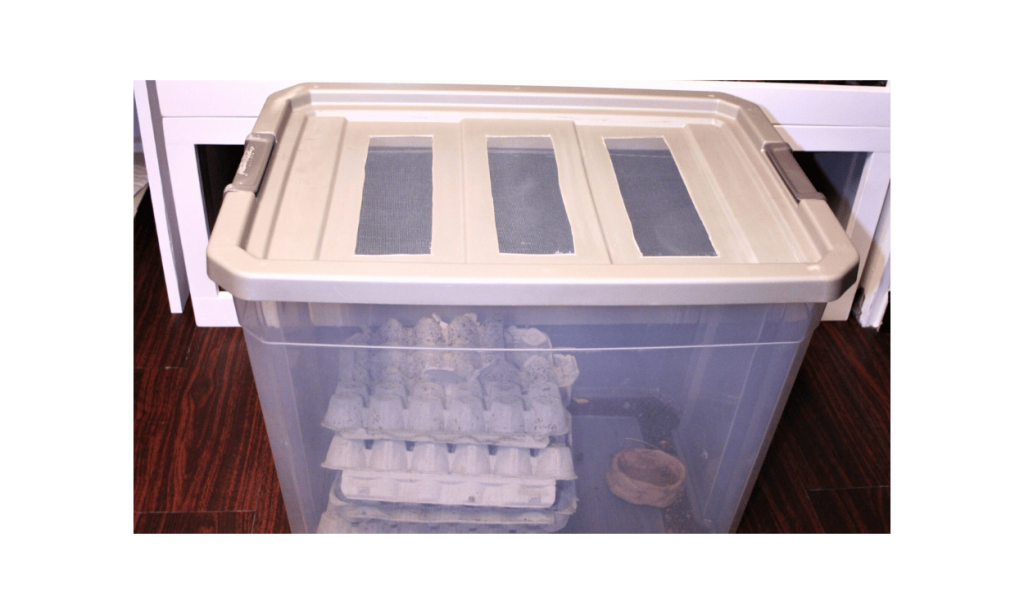
The size of the container depends on how many roaches you plan to breed, but as a general rule, a 10 to 20-gallon plastic bin is a great starting size for a small colony.
If you’re planning to grow a larger colony, you can upgrade to a bigger bin, around 30-50 gallons.
What’s important is not to overcrowd the container. Overcrowding can stress out the roaches, slow down breeding, and lead to health problems.
Make sure there’s enough space for the roaches to move around freely and for you to add egg crates or cardboard tubes.
Ventilation is key remember to add air holes or a screened lid to keep the air circulating and reduce humidity buildup.
2. Egg Crates or Cardboard Tubes
Roaches love dark, cozy places to hide and breed, so placing egg crates or cardboard tubes inside the container gives them plenty of hiding spots.
Stack them vertically to maximize space and create a comfortable environment for your roaches.
3. Heat Source
Since Dubia roaches thrive in warm environments, you’ll need a heat mat or heat lamp to maintain the right temperature.
Place the heat mat under one side of the container to create a temperature gradient, giving the roaches an area to warm up or cool down as they need.
4. Food and Water
Dubia roaches eat a variety of foods, such as ground-up grains, fresh fruits, and vegetables.
You’ll also need water crystals or a sponge to provide moisture, as standing water can drown the roaches. Avoid giving them too much food at once to prevent mold growth.
5. Hygrometer and Thermometer
A hygrometer helps you keep track of the humidity, while a thermometer ensures that the temperature stays in the ideal range.
Both are essential tools to monitor the environment and keep the roaches happy and breeding.
How Can You Tell If Dubia Roaches Are Breeding Successfully?
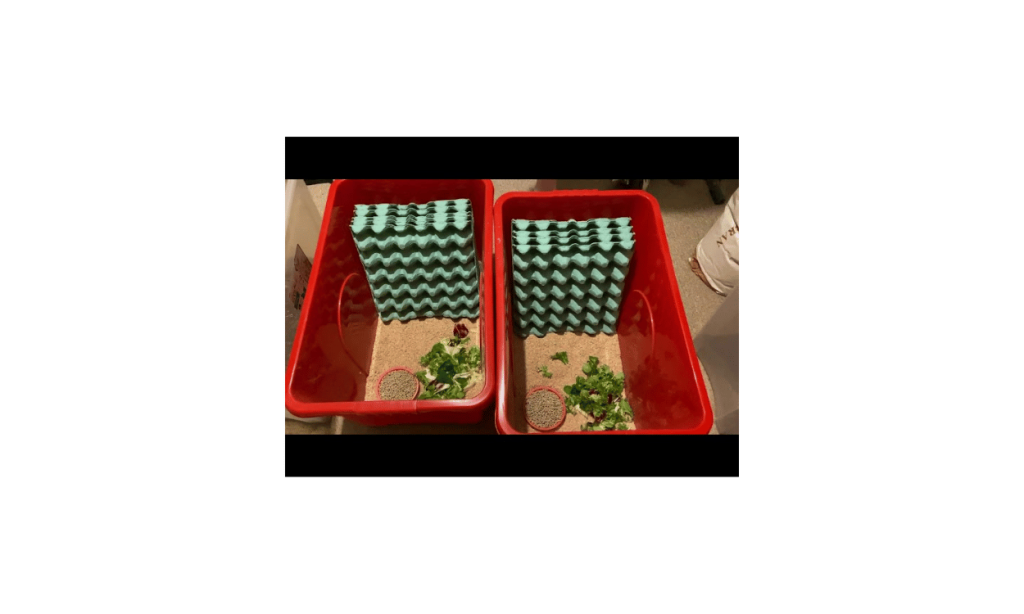
To see if your Dubia roaches are breeding successfully, there are a few fun signs to look for!
First, check for visible oothecae. These are small, brown egg cases that female roaches produce. If you spot these little capsules in their home, that’s a great sign that breeding is happening!
Next, keep an eye out for nymphs. After about a month, you might start seeing tiny, wingless baby roaches scurrying around. It’s like seeing the fruits of your labor—your breeding efforts are really paying off!
Lastly, look for healthy adult behavior. If your adult roaches are active and seem to be exploring and mating, it means they’re feeling happy and comfortable, which is a big thumbs-up for breeding! It’s so exciting to watch your colony grow!
How to Collect Roaches
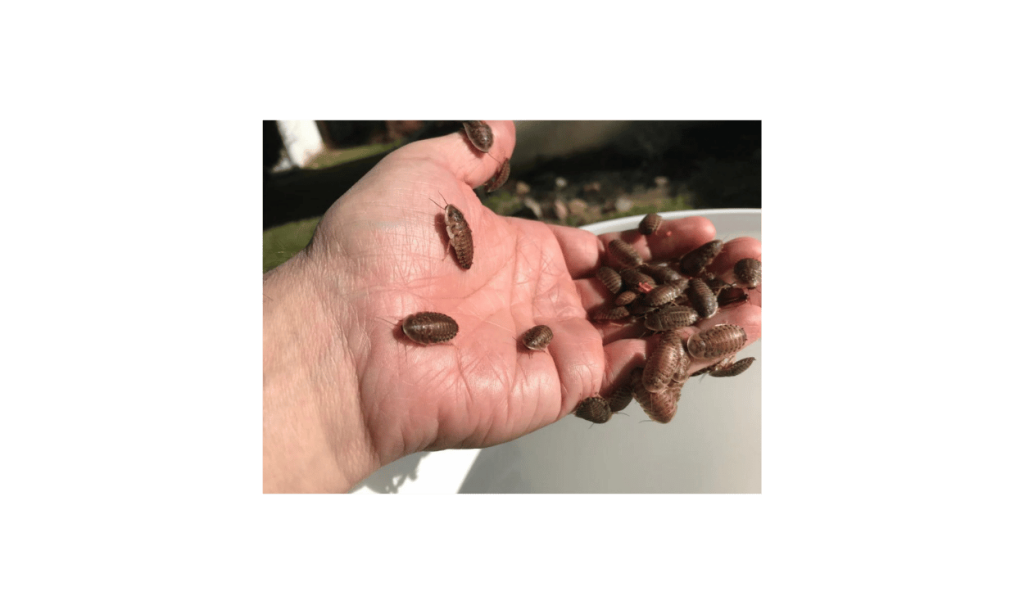
When it’s time to collect roaches, you want to do it carefully to avoid harming your breeding colony. Here’s how
- Harvest during cooler times, like early morning or late evening, when roaches are less active. This makes them easier to catch.
- Use a small cup or container to gently scoop them up. Avoid using your hands directly, as this can stress them out.
- If you’re having trouble catching them, you can lightly tap the container to encourage the roaches to move towards the opening.
- Only take what you need. This ensures your colony remains healthy and productive. Regularly harvesting a portion will keep the population balanced.
- After harvesting, check the colony’s health. Ensure that the remaining roaches have enough food and space to thrive.
See more: Can You Leave Dubia Roaches In Bearded Dragon Tank?
FAQ
Yes, dead Dubia roaches can produce an unpleasant odor as they decompose. It’s best to remove any dead roaches promptly to keep the colony healthy and odor-free.
No, Dubia roaches generally do not bite humans. They are docile creatures and prefer to avoid confrontation, so you don’t need to worry about getting bitten.
No, Dubia roaches cannot fly. They are winged insects, but their wings are not developed for flying. Instead, they prefer to run and scuttle around.
Final thoughts
If you’re excited about how to breed Dubia roaches for bearded dragons, you’re starting a great adventure! By making the right environment, giving them good food, and understanding what your roaches and your bearded dragon need, you’ll have a healthy colony that keeps your pet happy.
It might take some time and care, but seeing your roach population grow and knowing you’re feeding your dragon well is super rewarding. I hope you enjoy this journey and feel proud of what you’re doing! Happy breeding!

